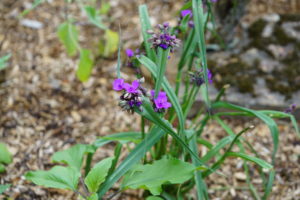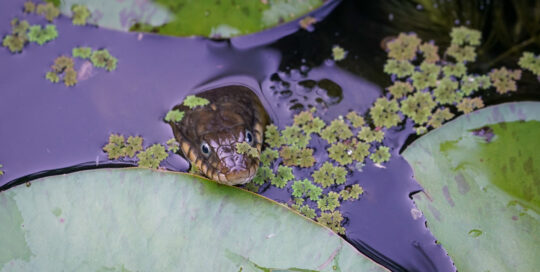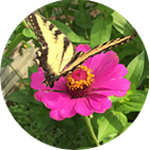Planting Spiderwort Will Help Bumblebees
Views: 1425

In early spring, I often see spiderwort, probably Tradescantia hirsuticaulis or occidentalis, near woodland edges in eastern Oklahoma. I’ve always thought they were quite beautiful. I threw out seeds at my old house, and the several that came up the next spring delighted me. Unfortunately, I didn’t bring any with me when I moved. So, I was quite thrilled to find Tradescantia ohiensis for sale at a local nursery this spring, under the name of “Ohio spider lily.” I snatched one up because planting spiderwort helps bumblebees.
Species
Tradescantia are perennials native to North America. There are many different species including, but not limited to, Zigzag Spiderwort (T. subaspera), Virginia Spiderwort (T. viginiana), Ohio Spiderwort (T. ohiensis), and the aforementioned Hairystem Spiderwort (T. hirsuticaulis) and Prairie Spiderwort (T. occidentalis).
Specifics
Spiderworts have long, blade-like leaves that droop. Some think the leaves look like spider legs, a likeness from where they found their name. They’re typically a fairly tall plant, up to 3 feet tall, but with a narrow spread. Most have flowers petals in shades of blue or blue-violet with contrasting bright yellow anthers on the stamens. Each flower has three petals.

Most spiderworts are actually quite drought tolerant, despite many being found in part shade and woodland openings. Some will go dormant in hot, dry summers. They also tolerate a wide variety of soils, from rich to poor, and sand to clay. It’s best to research the specific variety for its preferences, but chances are fairly good it will do well wherever you decide to plant it. It is typically an easy plant to grow. They are deer resistant, too.
Spiderworts tend to form clumps, so give them room to spread. You can use them in woodland or shade gardens, wildflower meadows, or areas with part shade. They can also be used in containers.
Benefit to wildlife
The spiderworts at my old house bloomed early in spring before many other flowers bloomed, so the pollinators always welcomed them. I saw honeybees, early butterflies, and native bees on them, including my favorites, the bumblebees.
Meet Leslie Miller
Leslie Ann Miller shares 3.5 acres in rural Oklahoma with birds, butterflies and wide variety of animals. She is currently transforming her yard with plantings…
Leslie's Recent Posts

The Joy of Being a Wildlife Gardener: Wally and Wallaby






